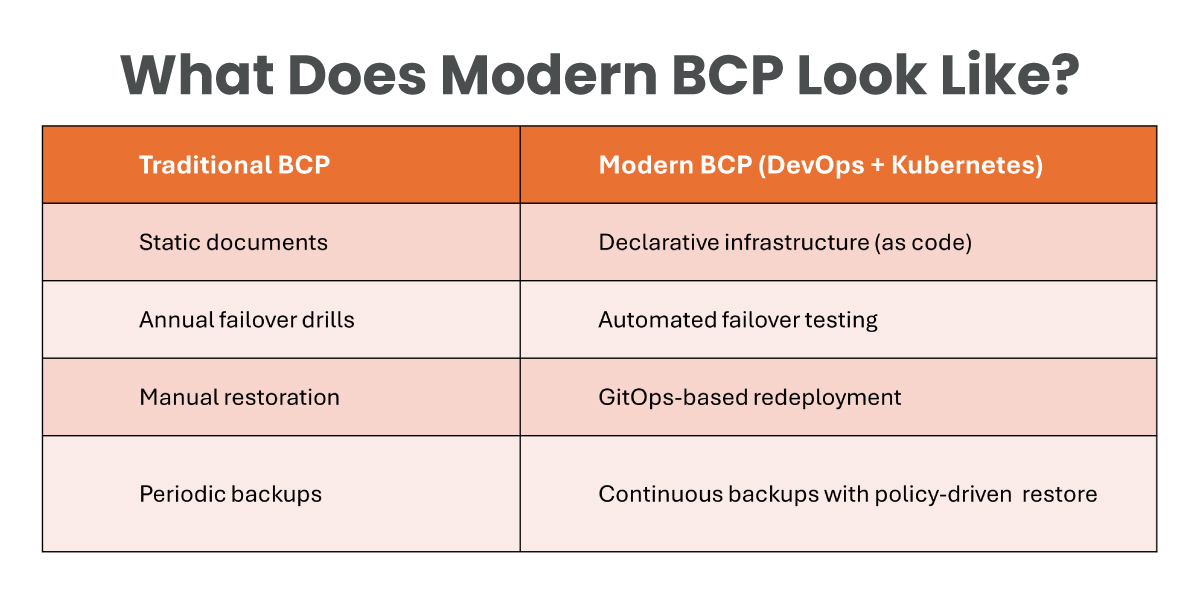Resilience by Design: A Business Leader’s Guide to Implementing Business Continuity with Modern DevOps
DevOps
– 6 Min Read
DevOps
– 6 Min Read
In today’s always-on digital economy, organizations can’t afford to treat business continuity as an afterthought. From customer-facing applications to mission-critical back-end systems, any unexpected outage can quickly spiral into major operational and financial setbacks. As businesses continue to embrace cloud-native technologies, traditional continuity models are proving too rigid, too manual, and too slow to respond.
Business leaders now face a pressing need: to embed resilience directly into the architecture of their operations. Leveraging the speed, automation, and scalability of modern DevOps practices—especially Kubernetes—has become a strategic necessity. This end‑to‑end approach exemplifies Kubernetes Business Continuity in practice.
In heavily regulated industries such as banking, healthcare, and insurance, downtime is more than an inconvenience—it’s a significant liability. Service disruptions caused by cyber-attacks, system failures, or human error can result in:
Despite these risks, many business continuity planning (BCP) strategies remain outdated. Traditional approaches rely on static documentation, annual disaster recovery (DR) drills, and manual procedures that are no match for today’s fast-paced, complex environments.
Enter: Resilience by Design — a modern BCP framework powered by DevOps, Kubernetes, and automation. Business Continuity Solutions grounded in Kubernetes and DevOps give enterprises a concrete playbook for true resilience.
Business Continuity Solutions grounded in Kubernetes and DevOps give enterprises a concrete playbook for true resilience.
Transforming your business continuity plan from a reactive framework to a resilient-by-design strategy requires embracing four essential DevOps principles. Each principle leverages cloud-native technologies and automation to reduce downtime, enforce compliance, ensure backup, and enable seamless recovery. Together, they form the backbone of a modern continuity architecture built for scale, speed, and security. Taken together, these DevOps for Business Continuity practices help enterprises standardize resilience at the cadence of modern software delivery.




In the age of digital transformation, business continuity isn’t about preparing for “if” disruptions occur, but “when.”
By integrating DevOps practices and Kubernetes-native tools into business continuity plans, organizations in regulated industries can:
Key Takeaway : Resilience is no longer optional or an afterthought—it’s a deliberate and strategic design choice. Organizations that adopt comprehensive Kubernetes business continuity solutions will be best positioned to stay ahead of unexpected disruption.
It’s a proactive approach to business continuity that integrates DevOps, automation, and Kubernetes to ensure rapid recovery and operational reliability.
GitOps enables declarative infrastructure management, allowing teams to rebuild entire environments directly from version-controlled repositories.
They’re too static and manual to handle the dynamic, distributed nature of modern cloud-native applications.
No, it needs to be coupled with resilient architecture patterns, automation, and multi-cluster strategies.
RTO (Recovery Time Objective) defines how quickly systems must be restored; RPO (Recovery Point Objective) defines the maximum data loss acceptable in time.